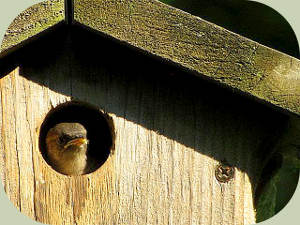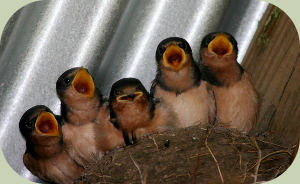Free Birdhouse Plans

If you love birds, then try building based the free birdhouse plans available here. This will provide birds with much needed nesting and roosting habitat and give you a better opportunity to observe the intimate moments of their lives more closely. Here are some things to consider and also some birdhouse plans for you to try out.
Free Birdhouse Plans:
Design Considerations
As you may have already realized, birds come in many different shapes and sizes. Not all birds use cavities - such as those provided within birdhouses – for nesting purposes. Think about exactly what species you wish to encourage in your yard and do a little bit of research to see if that bird species will actually use a bird house for nesting or roosting.
If you live in the Pacific Northwest region, here is a short list of species that are cavity nesters and might use your bird house:
- Black-capped chickadees
- House, Bewick's and winter wrens
- Red-breasted and white-breasted nuthatch
- Wood ducks, buffleheads, common goldeneye, common and hooded mergansers
- American kestrel
- Barn owl, barred owl, western screech owl, boreal owl, northern saw-whet owl
- A variety of woodpecker species
Keep Them Safe
When cutting out the entrance to your birdhouse, remember to keep it as close to the diameter of the body of your bird species of choice. Although smaller birds will sometimes utilize birdhouses with over-sized entrances, those birds are often much more likely to lose their eggs or young to predation.
In utilizing your free birdhouse plans, it helps to keep in mind that you can do certain things to minimize predation or competition with more aggressive bird species. Although adding a perch underneath the entrance of birdhouse might be aesthetically pleasing, it can greatly increase the accessibility of the inside of the birdhouse to predators. Species such as crows, ravens, jays, weasels, raccoons and house cats are known to be nest predators. According to research on nest predation done by the University of Washington, it is squirrels and mice that are the most frequent predators on bird eggs.
Choosing Materials
When choosing what materials to use in constructing the box according to the free birdhouse plans, consider using all natural materials. Materials such as cedar, locust or other long-lasting, rot resistant woods are a great choice. It is important that the wood used in the construction does not have any stains or preservatives on it as the fumes can harm the nesting birds.
Be More Prepared For Your Next Outdoor Adventure!

Don't leave home without knowing these six essential survival skills. Our free survival mini guide reveals the strategies of:
- Shelter & fire to prevent the number one cause of death
- Obtaining clean water to avoid life-threatening dehydration
- Common wild survival foods and other critical skills!

Keep It Accessible
Part of keeping your birds safe involves being able to check on the nest once in a while as well as offering you access to clean out the box at the end of the nesting season. Boxes that open from the top are the least disturbing to the birds. Do not make your birdhouse open from the bottom, as the nest is likely to fall out. Keeping the nest boxes clean is important in keep parasites down to a minimum. If you find that the nesting box is infested with parasites, it is best not to spray any insecticides into the birdhouse. Try cleaning out the inside of the birdhouse with soap and water, white vinegar or some other non-toxic cleaning solutions.
Location, location, location
Once you have made a home for the birds using the free birdhouse plans, look around carefully for a good location to place the box. Consider a height that would be convenient for you, after all you want to have a good look at the birds as they go about their lives. Do not put bird houses near bird feeders. Do not put more than one birdhouse in a single tree in your yard, unless it is a very large tree or unless you have birdhouses for multiple species. Building several boxes and spreading them throughout your yard is a good idea, however, space them out well. If your bird houses are not being used, consider moving them to new locations as birds can be very particular about where they choose to nest.
A Variety of Free Plans Online:
Click on the following links to see a variety of birdhouse plans and designs:
- https://www.birdwatching-bliss.com/bird-house-plans.html
One great source of information online for details on making and learning more about building birdhouse is the U.S. Fish & Wildlife, you can find the information all condensed and easily accessible here:
Related Courses:
Wildlife Tracking Courses at Alderleaf
By the way, when you're out birding, it's important to know how to stay safe in the outdoors, especially if you were to get lost. Right now you can get a free copy of our mini survival guide here, where you'll discover six key strategies for outdoor emergencies, plus often-overlooked survival tips.

About the Author: Filip Tkaczyk is a periodic guest teacher at Alderleaf. He also wrote the field guide Tracks & Sign of Reptiles & Amphibians. Learn more about Filip Tkaczyk.

Return from Free Birdhouse Plans back to Birding Articles
Is The Essential Wilderness Survival Skills Course Right for You? Take the "Online Survival Training Readiness" Quiz
See for yourself if this eye-opening course is a good fit for you. It takes just a few minutes! Get your Survival Training Readiness Score Now!

Grow Your Outdoor Skills! Get monthly updates on new wilderness skills, upcoming courses, and special opportunities. Join the free Alderleaf eNews and as a welcome gift you'll get a copy of our Mini Survival Guide.

 The Six Keys to Survival: Get a free copy of our survival mini-guide and monthly tips!
The Six Keys to Survival: Get a free copy of our survival mini-guide and monthly tips!
Learn more